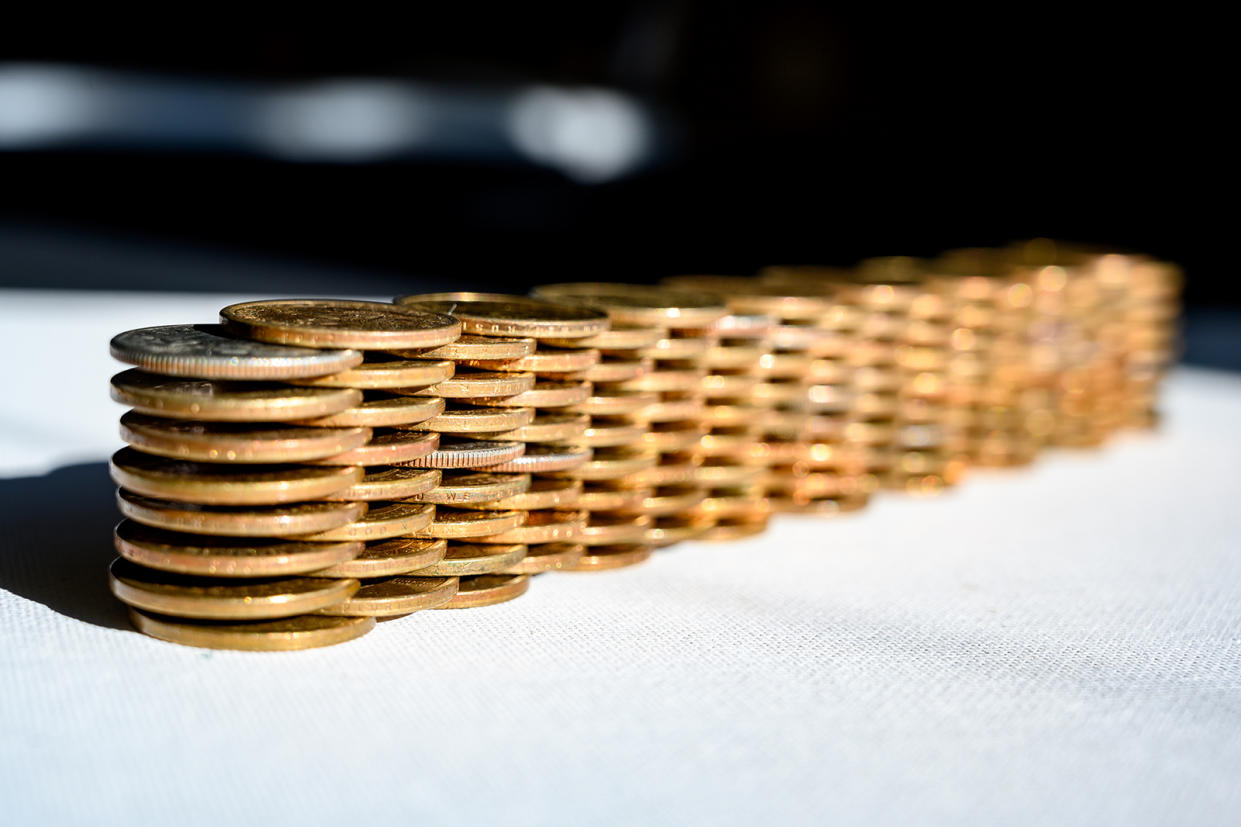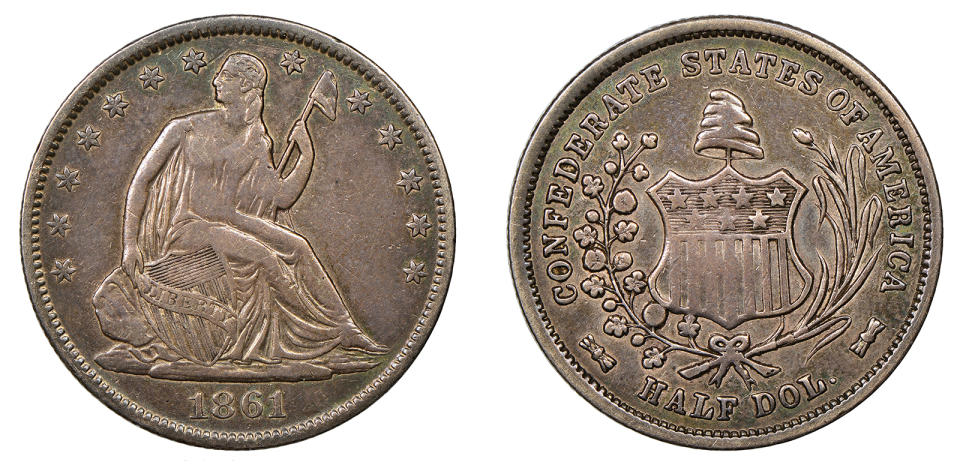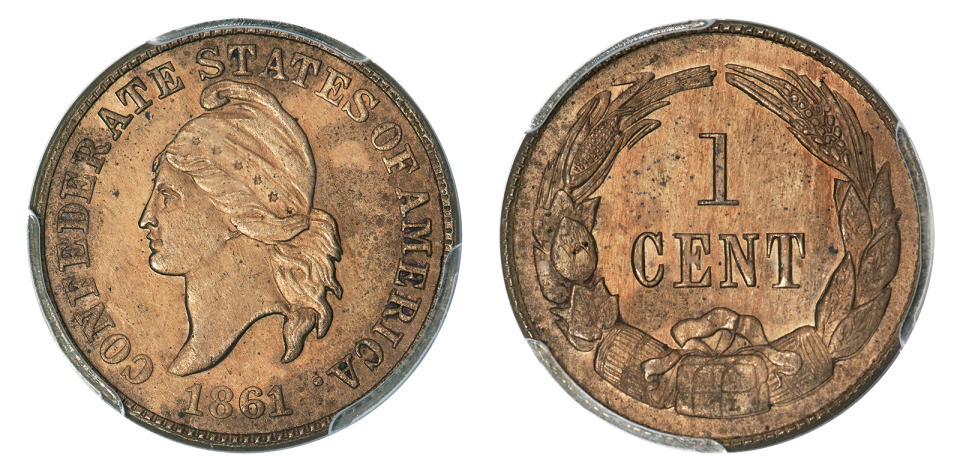Two Ultra-Rare Confederate Coins & the Stories Behind Them

Although you may have heard of the famously devalued Confederate paper currency, the American Civil War also saw the Confederacy minting a few coins (we're talking very, very few). The Confederate coins are some of the rarest of the rare today, and they're super valuable. They're also an amazing relic of the Civil War, and the stories behind them are fascinating.
Confederate Coin and Replica Coin Values
There are very few of these coins, so there's not a lot to go on for value.
Coin Type | Value |
|---|---|
Confederate States of America half-dollar | $960,000 |
Confederate States of America half-dollar reproduction (early re-strike) | $28,750 |
Confederate States of America Cent | $216,000 |
Confederate Penny reproduction (early re-strike) | $52,875 |
Why Confederate Coins Are So Rare
Although the Confederacy controlled some of the US Mints during the Civil War, producing new dies for specialized Confederate coinage was far too costly for the limited resources of the fledgling country. The Confederate-controlled mints mostly continued minting coins stamped with the United States of America and using Union dies (at least until they ran out of the metals needed to mint those coins). These coins are mostly indistinguishable from other coins of the time. Even though they were minted in Confederate-controlled mints, no one really considers them Confederate coins.
Related: 10 Most Valuable Rare Pennies & Their Fascinating Stories
Two Rare Confederate Coins Worth Thousands
Even though making new coin dies was expensive, the Confederacy did want its own currency. There were two significant attempts to create it that resulted in a few coins. Those coins came in two different designs, each with its own story.
1861 Confederate States of America Half Dollar
In 1861, the Confederacy decided to begin minting silver half dollars. The front of the coin looks exactly like the United States half dollar of the time because it used the same dies of Lady Liberty seated with flowing robes. (Remember, die production was very expensive, so this saved them money.) The back of the coin is a unique design, however. It reads "Confederate States of America" and "Half Dol."
Only four examples of this coin were ever minted, making this the rarest Confederate coin. They were given to four different people to consider and help decide whether to move forward with general issue of the coin into circulation. The events of the war intervened before they could move forward when New Orleans fell to the Union, and the Confederacy lost control of the mint there.
Because only four were ever made, this Confederate coin's value is among the highest of all American coins. Two have been sold at Heritage Auctions. In 2015, one sold for $881,250, and in 2017, another fetched $960,000.
Even though there are only four real 1861 Confederate half dollars, commemorative tokens and fakes were issued in the decades after the war. John W. Scott owned the original die for the back of the half dollar and made tokens and replicas that looked very real. These weigh slightly less than an original half-dollar, but they're still valuable. One sold in 2011 for $28,750.
1861 Confederate States of America Cent
The second Confederate coin is the 1861 penny, and its story is really mysterious. In early 1861, the Confederate States considered themselves a country, but the war had not yet started. Some people believe the Confederacy or Southern sympathizers commissioned engraver Robert Lovett, Jr. of Philadelphia to design and create dies for a Confederate penny, although there aren't historical records to support this agreement.
What is known is that none of these coins were struck in Confederate-controlled mints, but Lovett secretly made up to 16 of them on his own. The story goes that he accidentally spent one of the pennies in a bar several years later.
The 1861 Confederate penny has Lady Liberty on the front with the words "Confederate States of America" and the year 1861. On the back, it has a wreath of agricultural crops like corn, cotton, and tobacco and "1 cent." No matter how they came to exist, these pennies are very valuable because they're so rare. One sold in 2024 for $216,000.
Lovett sold the dies for the 1861 Confederate penny at some point, and there were some restrikes made after the war. You may see these in copper, silver, or gold. Even the restrikes can be valuable with an auction record of $52,875 for a copper version.
How to Tell if a Confederate Coin Is Real
A lot of people wonder how to tell if a Confederate coin is real, but the truth is any coin you have probably isn't real. There are only a handful of real Confederate coins, but there are a lot of commemorative tokens made after the Civil War. You can still buy sets of replica Confederate coins at battlefield sites today.
Here are some ways to tell a real Confederate coin from a replica:
Weight - Experts can tell whether an 1861 Confederate half-dollar is real or fake by weighing it. Real coins are slightly heavier than restrikes because they contain a bit more metal.
Details - Because both the real 1861 Confederate coins were the first strikes from their dies, the coins that came after them may have less distinct details as the dies degraded.
Age - Modern reproductions, such as battlefield souvenir coins, don't have the patina of age. In many cases, they look newer because they are newer.
Ultimately, there are only two known Confederate coin designs and a handful of examples that are known to exist. However, that doesn't mean that a restrike or early token isn't valuable. They can be worth thousands. If your coin looks old and you think it's an early restrike, it's worth getting it appraised.
Confederate Coins Are Valuable for a Reason
Real Confederate coins are incredibly valuable for a reason: they offer a glimpse at a very short period of history. They're also very, very rare. Even if you may never encounter one of these coins in your pocket change (or even your grandpa's coin collection), just knowing their stories is fascinating and fun.




